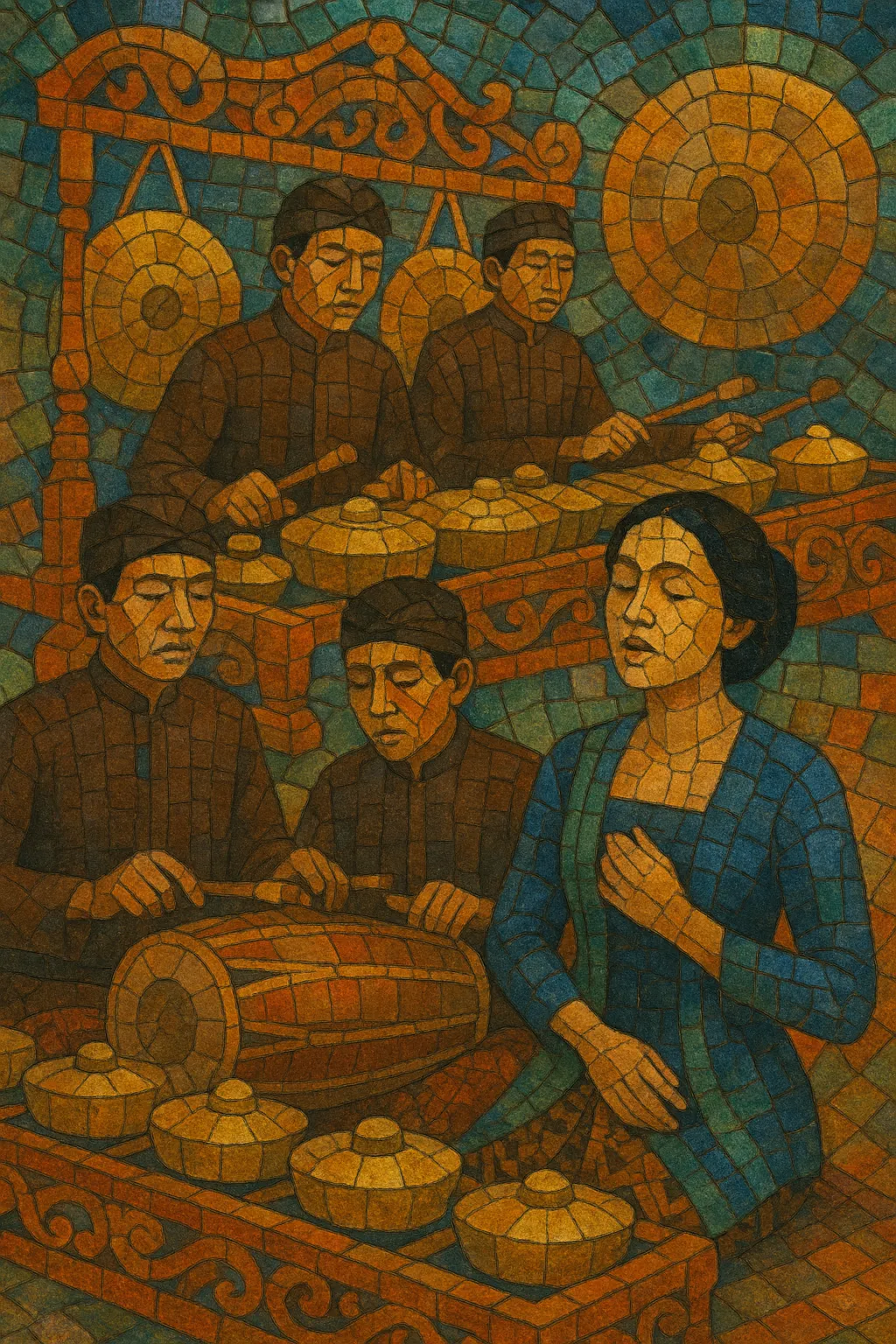Gamelan Surakarta is the Central Javanese court style of gamelan centered in the royal palaces of Surakarta (Solo) and the Mangkunegaran in Central Java, Indonesia. It is prized for its halus (refined) character, balanced sonorities, and supple pacing, distinguishing it from related styles such as the Yogyakarta court tradition.
The music is built on layered heterophony: a core melody (balungan) played by metallophones is encircled by elaborating instruments (bonang, gender, gambang, siter, rebab) and articulated by the colotomic gongs (gong ageng, kempul, kenong, kethuk, kempyang). Kendhang (drums) lead the ensemble’s flow, while solo female voice (sindhen) and male chorus (gerong) add lyrical lines. The modal system (pathet) in slendro and pelog tunings, and flexible density-tempo relationships (irama), shape its contemplative yet powerful expressive palette.
Surakarta (Solo) became a major Javanese court center in the mid-18th century, inheriting and refining older Mataram musical practices. By the 1800s, palace ateliers (kraton and Mangkunegaran) consolidated ensembles, rituals, and repertories—especially for dance (bedhaya, serimpi) and wayang kulit (shadow theater). This period set the aesthetic ideals of halus (refinement), balance, and controlled expressivity that define the Surakarta sound.
Through the 19th century, repertories such as ketawang, ladrang, lancaran, and large-scale gendhing crystallized. Court musicians and scholars systematized modal usage (pathet), irama (density/tempo levels), and performance etiquette. Under patrons like Pakubuwono X, palace ensembles flourished, and instrument sets of great prestige (with distinct names and histories) were curated.
In the 20th century, teaching centers in Solo—most notably the Konservatori Karawitan (later ASKI/STSI/ISI Surakarta)—standardized pedagogy, adopted kepatihan cipher notation for instruction, and trained generations of musicians. Influential figures such as R. Ng. Martopangrawit and Rahayu Supanggah deepened scholarly and creative engagement, while radio and recording broadened the audience.
From the late 20th century onward, Surakarta-style gamelan has been taught and performed worldwide. Collaborations with dance, theater, and contemporary composition proliferated, and the Surakarta aesthetic informed global understandings of Javanese music. Today, palace ensembles and ISI Surakarta remain reference points, sustaining tradition while inspiring new works and intercultural projects.
Start by selecting the laras (tuning): slendro (five-tone) or pelog (seven-tone). Then choose a pathet (mode), such as slendro nem/sanga/manyura or pelog lima/nem/barang, which guides melodic range, cadential tones (seleh), and affect. Decide on a form—ketawang, ladrang, lancaran, or a larger gendhing—and the colotomic cycle length (e.g., ketawang 16-beat, ladrang 32-beat).
Compose a clear balungan (core melody) that outlines pathet and cadences. Map it onto the colotomic structure: place gong ageng at phrase endings, with kenong, kempul, kethuk, and kempyang articulating subdivisions. Plan irama changes (tanggung → dadi → wilet → rangkep) to control density and pacing.
Provide cengkok (melodic patterns) for gender, bonang barung/panerus, rebab, gambang, and siter. These elaborate around the balungan according to pathet conventions. The kendhang leads: write or indicate drumming patterns for starts (buka), transitions, dance cues, and endings. Include sindhen (solo female voice) and gerong (male chorus) entries, optionally preceded by a bawa (solo vocal prelude) or pathetan (free-tempo modal intonation).
Use the Surakarta aesthetic: refined dynamics, smooth transitions, and balanced timbres. Favor timbral blend over virtuosity for its own sake. Let cadences settle on seleh tones and allow space for vocal ornamentation. While kepatihan notation can document the piece, prioritize memorization and ensemble listening to realize appropriate rasa (feeling).


